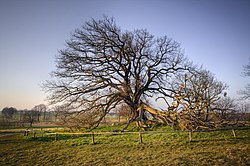Large stone graves near Suckow
| Large stone graves near Suckow | ||
|---|---|---|
|
The preserved grave 1 |
||
|
|
||
| Coordinates | 53 ° 54 '55.7 " N , 13 ° 57' 18.2" E | |
| place | Rankwitz , Mecklenburg-Western Pomerania , Germany | |
| Emergence | 3500 to 2800 BC Chr. | |
The megalithic graves near Suckow were probably two megalithic tombs of the Neolithic funnel cup culture near Suckow , a district of Rankwitz on the island of Usedom in the district of Vorpommern-Greifswald ( Mecklenburg-Western Pomerania ). Only one of them still exists today. The second grave was destroyed in the 19th century, but previously examined archaeologically .
location
According to a report by the preacher Strecker from Morgenitz in 1831, there were originally two large stone graves north of Suckow, which were about 200 paces (approx. 150 m) apart on the north and south slopes of two hills that bordered a bog.
description
Grave 1
According to Strecker, the grave originally had an oval stone enclosure and a north-south oriented burial chamber . The entire facility was 36 feet (about 12 m) long and 10 feet (about 3 m) wide. All he wrote about the burial chamber was that at the northern end there were large blocks of stone in two places.
Today only a mound of earth with a few medium-sized stones can be seen. It is not entirely clear whether the system obtained is really identical to the one described by Strecker. It is described on the information board as a prehistoric burial mound and not as a large stone grave without further details . In 1972, however, Ewald Schuldt clearly identified the preserved system with the one described by Strecker. In his report, however, Strecker does not mention the distinctive, several hundred year old Suckower Oak that grows directly on the hill.
Grave 2
The second grave was a little smaller than the first. In 1825 the stones of the enclosure were removed and the grave was examined in the presence of the preacher Strecker. Only one stone was visible on the surface of the burial chamber. Upon exposure, it was found to face east-west and was 10 feet long, 6 feet wide, and 3 feet high. 9 m). The floor was paved with flint grit. In places there was a layer of reddish earth. Above that the chamber was filled with sand.
Some bones remained from the burials, including a piece of a skull. Ceramic shards as well as flint blades, a smooth flint ax and "several small sharp flints" ( cuts ? Arrowheads ?) Were found among grave goods . The ax came into private hands, its whereabouts are unknown.
literature
- Sixth annual report of the Society for Pomeranian History and Archeology from June 15, 1830 to 1831. In: Baltic Studies. Volume 2, 1833, pp. 181-182 ( online ).
- Hans-Jürgen Beier : The megalithic, submegalithic and pseudomegalithic buildings as well as the menhirs between the Baltic Sea and the Thuringian Forest. Contributions to the prehistory and early history of Central Europe 1. Wilkau-Haßlau 1991, p. 15.
- Ewald Schuldt : The Mecklenburg megalithic graves. Research on their architecture and function. VEB Deutscher Verlag der Wissenschaften, Berlin 1972, p. 125.
Web links
- The Megalithic Portal: Suckow Stone Tomb
- KLEKs Online: Great Stone Grave (Suckow 1)
- strahlen.org: Megalithic graves and menhirs in Mecklenburg-Western Pomerania. Grave mound "Suckow", Suckow near Usedom, Usedom Island

